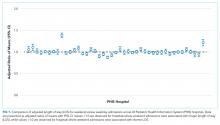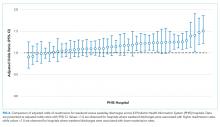Association of Weekend Admission and Weekend Discharge with Length of Stay and 30-Day Readmission in Children’s Hospitals
BACKGROUND: Worse outcomes among adults presenting for/receiving care on weekends (ie, “the weekend effect”) have been observed for many diseases. However, little is known about the overall impact of the weekend effect in hospitalized children.
OBJECTIVE: To determine the association between weekend admission and length of stay (LOS) and between weekend discharge and 30-day all-cause readmission.
METHODS: We conducted a retrospective, cross-sectional study of children hospitalized between October 1, 2014 and September 30, 2015 using the Pediatric Health Information System. Birth hospitalizations and planned procedures were excluded. We used generalized linear mixed modeling to assess the independent association between weekend admission and LOS and weekend discharge and readmission risk.
RESULTS: Among 390,745 hospitalizations across 43 hospitals, the median LOS was 41 hours (interquartile range [IQR] 24-71) and the 30-day readmission rate was 8.2% (IQR 7.2-9.4). We observed no association between weekend admission and LOS (adjusted LOS [95% CI: weekend 63.70 [61.01-66.52] hours vs weekday 63.40 [60.73-66.19] hours, P = .112). Weekend discharge was associated with slightly increased odds of readmission compared with weekday discharge (adjusted probability of readmission [95% CI]: weekend 0.13 [0.12-0.13] vs weekday 0.11 [0.11-0.12], P < .001) but was variable among individual hospitals. Patient characteristics (ie, number of chronic conditions) were more strongly associated with LOS and readmission risk than weekend admission or discharge.
CONCLUSIONS: Patient-level factors (ie, clinical and demographic characteristics) are more indicative of longer LOS and readmission risk than weekend admissions or discharges. The overall impact of the weekend effect across children’s hospitals was minimal.
© 2018 Society of Hospital Medicine
Admission Demographics for Weekends and Weekdays
Among the included hospitalizations, 92,266 (23.6%) admissions occurred on a weekend (Supplementary Table 1). Overall, a higher percentage of children <5 years of age were admitted on a weekend compared with those admitted on a weekday (53.3% vs 49.1%, P < .001). We observed a small but statistically significant difference in the proportion of weekend versus weekday admissions according to gender, race/ethnicity, payer, and median household income quartile. Children with medical complexity and those with technology dependence were admitted less frequently on a weekend. A higher proportion of children were admitted through the emergency department on a weekend and a higher frequency of ICU utilization was observed for children admitted on a weekend compared with those admitted on a weekday.
Association Between Study Variables and Length of Stay
In comparing adjusted LOS for weekend versus weekday admissions across 43 hospitals, not only did LOS vary across hospitals (P < .001), but the association between LOS and weekend versus weekday care also varied across hospitals (P < .001) (Figure 1). Weekend admission was associated with a significantly longer LOS at eight (18.6%) hospitals and a significantly shorter LOS at four (9.3%) hospitals with nonstatistically significant differences at the remaining hospitals.
In adjusted analyses, we observed that infants ≤30 days of age, on average, had an adjusted LOS that was 24% longer than that of 15- to 17-year-olds, while children aged 1-14 years had an adjusted LOS that was 6%-18% shorter (Table 1). ICU utilization, admission through the emergency department, and number of chronic conditions had the greatest association with LOS. As the number of chronic conditions increased, the LOS increased. No association was found between weekend versus weekday admission and LOS (adjusted LOS [95% CI]: weekend 63.70 [61.01-66.52] hours versus weekday 63.40 [60.73-66.19] hours, P = .112).
Discharge Demographics for Weekends and Weekdays
Of the included hospitalizations, 127,421 (32.6%) discharges occurred on a weekend (Supplementary Table 2). Overall, a greater percentage of weekend discharges comprised children <5 years of age compared with the percentage of weekday discharges for children <5 years of age (51.5% vs 49.5%, P < .001). No statistically significant differences were found in gender, payer, or median household income quartile between those children discharged on a weekend versus those discharged on a weekday. We found small, statistically significant differences in the proportion of weekend versus weekday discharges according to race/ethnicity, with fewer non-Hispanic white children being discharged on the weekend versus weekday. Children with medical complexity, technology dependence, and patients with ICU utilization were less frequently discharged on a weekend compared with those discharged on a weekday.
Association Between Study Variables and Readmissions
In comparing the adjusted odds of readmissions for weekend versus weekday discharges across 43 PHIS hospitals, we observed significant variation (P < .001) in readmission rates from hospital to hospital (Figure 2). However, the direction of impact of weekend care on readmissions was similar (P = .314) across hospitals (ie, for 37 of 43 hospitals, the readmission rate was greater for weekend discharges compared with that for weekday discharges). For 17 (39.5%) of 43 hospitals, weekend discharge was associated with a significantly higher readmission rate, while the differences between weekday and weekend discharge were not statistically significant for the remaining hospitals.









